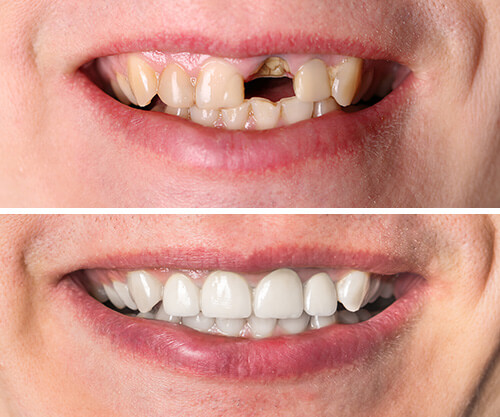Restorations

Dental restorations are procedures performed to repair or replace damaged, decayed, or missing teeth. These restorations aim to restore the function, integrity, and appearance of the teeth. There are various types of dental restorations, and the choice depends on the specific condition and needs of the individual.
Here are some common dental restorations:
1. Dental Fillings: Fillings are used to repair teeth affected by cavities or minor damage. The decayed or damaged portion of the tooth is removed, and the resulting space is filled with a suitable material, such as composite resin, amalgam, or glass ionomer cement. Dental fillings restore the tooth’s shape and function, preventing further decay and strengthening the affected tooth.
2. Dental Crowns: Dental crowns, also known as caps, are used to restore extensively damaged or weakened teeth. A crown covers the entire visible portion of the tooth above the gumline, protecting it and restoring its shape, size, strength, and appearance. Crowns can be made from various materials, including porcelain, metal alloys, or a combination of both.
3. Dental Bridges: Dental bridges are used to replace one or more missing teeth by anchoring artificial teeth (pontics) to adjacent natural teeth or dental implants. The natural teeth or implants on either side of the gap are prepared and crowned, serving as supports for the bridge. The pontics fill the space left by the missing teeth, restoring functionality and aesthetics.
4. Dental Implants: Dental implants are a popular and long-lasting solution for replacing missing teeth. They involve the surgical placement of titanium posts into the jawbone, which serve as artificial tooth roots. Once the implants integrate with the bone, they can support individual crowns, bridges, or even full arches of artificial teeth, providing a stable and natural-looking restoration.
5. Dentures: Dentures are removable dental appliances used to replace multiple missing teeth or complete arches of missing teeth. They consist of artificial teeth set in a pink or gum-colored acrylic base. Dentures can be complete (replacing all teeth) or partial (replacing some missing teeth), and they rely on the support of the surrounding oral tissues and, in some cases, dental implants.
6. Dental Veneers: Dental veneers are thin, custom-made shells typically made of porcelain or composite resin. They are bonded to the front surface of teeth to improve their appearance by covering imperfections like stains, chips, or misalignments. Veneers provide a natural-looking and durable restoration for enhancing the aesthetics of the smile.
These are just a few examples of dental restorations commonly used in dentistry. The specific treatment recommended for you will depend on factors such as the extent of damage or tooth loss, your oral health condition, budget, and personal preferences. Consulting with a dentist or prosthodontist is essential to determine the most suitable dental restoration option for your specific needs. They will conduct a thorough examination, discuss your treatment options, and help you make an informed decision.
Frequently Asked Questions
1Q. What is restoration treatment?
Ans: Enjoy pain-free tooth restoration at Finedent Dental Clinic in Nallagandla, Hyderabad. Our experienced team employs modern techniques and anesthesia to ensure a comfortable and stress-free experience for all our patients.
2Q. Is tooth restoration expensive?
Ans: Experience affordable tooth restoration solutions at Finedent Dental Clinic in Nanakramguda, Hyderabad. Our transparent pricing ensures you receive top-quality dental care without breaking the bank.
3Q. Is tooth restoration permanent?
Ans: At Finedent Dental Clinic in Nallagandla, Hyderabad, achieve lasting results with our durable tooth restoration options. Our expertly crafted treatments are designed to provide long-term solutions for a confident and healthy smile.
4Q. Is tooth restoration expensive?
Ans: At Finedent Dental clinic in Nallagandla, Hyderabad, our skilled dental specialists perform root canal treatments aiming to eliminate infected or damaged nerves within the tooth, alleviating pain and preserving the tooth’s structure for long-term oral health.
